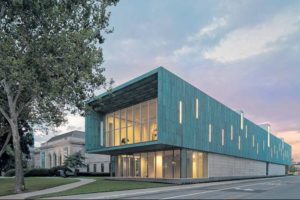 Congratulations to the Columbus Museum of Art, winner of the 2016 James B. Recchie Design Award!
Congratulations to the Columbus Museum of Art, winner of the 2016 James B. Recchie Design Award!
The Award recognized the Margaret M. Walter Wing Addition (2015), designed by DesignGroup, the Beaton Hall and 1931 Museum Building Renovation (2009, 2011), designed by Schooley Caldwell, and the landscaped areas and creative spaces surrounding the museum, designed by MKSK.
“The James B. Recchie Design Award recognizes all types of urban design including the preservation, restoration, rehabilitation or adaptive re-use of historic buildings, additions to historic buildings, new building design, landscape design, and public art. It is rare that one project encompasses all of these categories, and the jury noted that the Columbus Museum of Art restoration and renovation checks all of the boxes,” said Nancy Recchie, Historic Preservation Consultant with Benjamin D. Rickey & Co. and sister of the Award’s namesake. “Not only did it involve all of these elements, but they were done exceptionally well so that the whole ensemble is truly outstanding,” she added.
The James B. Recchie Award honors excellence in urban design that can be reflected in historic or new buildings and places, additions to existing buildings, parks, public spaces and public art. The award celebrates projects that add to the distinctive character and improved quality of life of Columbus and the designers responsible for them. Following a public nomination process, four finalists were selected by a screening committee. Jurors then determined the winner after visiting the five finalists. The 2016 jurors were Lavea Brachman, Co-Founder and former Executive Director of the Greater Ohio Policy Center; Curtis Moody, FAIA, President and CEO of Moody Nolan; and Carole Olshavsky, FAIA, Vice President of Program Management, The Pizzuti Companies.
The three other finalists for this year’s award were Cristo Rey Columbus High School, 400 E. Town St. Columbus, OH 43215, designed by Schooley Caldwell; The Julian Apartments, 272 South Front St. Columbus, OH 43215, designed by Sullivan Bruck Architects and Sandvick Architects; and Nationwide Children’s Hospital, 700 Children’s Drive Columbus, Ohio 43205, designed by FKP Architects (Houston, TX), Ralph Applebaum & Associates (NY, NY), and MKSK.
Thank you to our 2016 Sponsors!

Supporters: Jeff Darbee & Nancy Recchie, DeVere LLC, Dinsmore, Hardlines Design Company, MKSK, Moody-Nolan, In Memory of Joseph & Martha Recchie, Michael Wilkos
Hosts: Pat Henahan, Cynthia Hunt, Karen McCoy, Nancy Recchie, Charmaine Sutton
